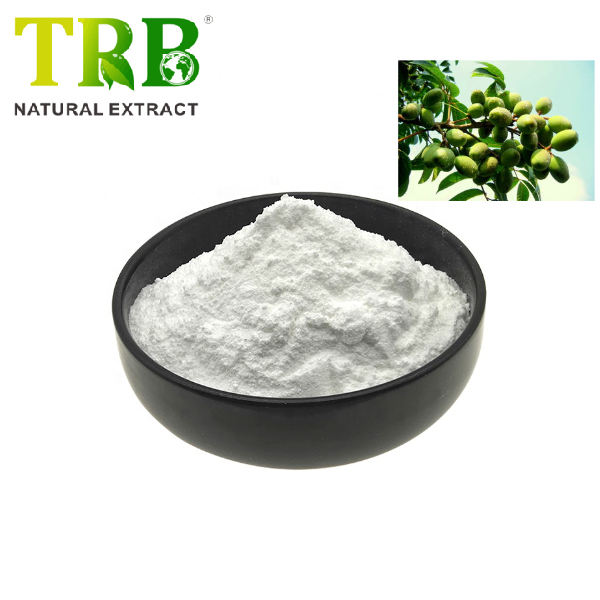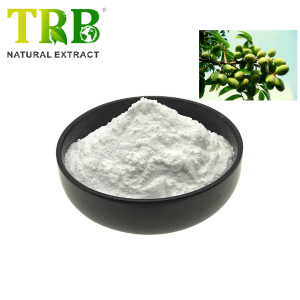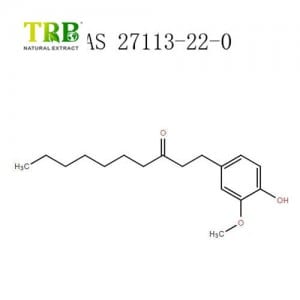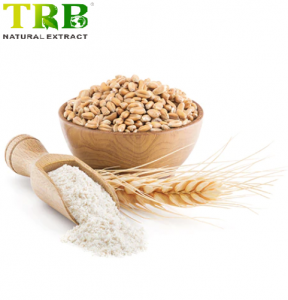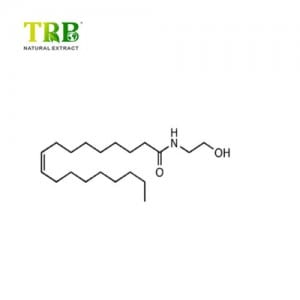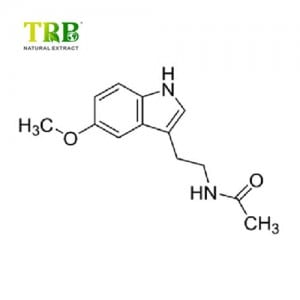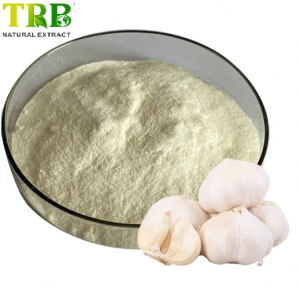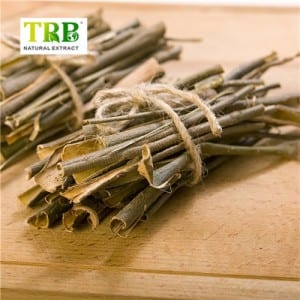Oleanolsyre som er en tre pentacykliske triterpenoider isolert fra Gentianaceae-planter av Swertia mileensis hele gresset eller ligusterfrukten, med en fri kropp og glykosider i mange planter.Oleanolsyre har et bredt spekter i planter, og gjennomsnittlig innhold er 0,2 % – 2 %.Cucurbitaceae høyt innhold er 1,5% ~ pukkelbunn 2%, liguster frukt innhold på 0,6% ~ 0,7%. Oleanolsyre er en slags pentacyklisk triterpenoid forbindelse isolert fra frukten av slekten Asteraceae, Syzygium sylvestris eller Ligustrum lucidum.Det er en adjuvans for leversykdom og brukes klinisk for terapeutisk infeksjon.Akutt gulsott hepatitt har åpenbare effekter på å redusere alaninaminotransferase og gulning. Oljesyre er en pentacyklisk triterpenoid isolert fra frukten av swertia chinensis eller fructus ligustris fra gentianaceae-planten.Oleanolsyre er mye funnet i planter, med et generelt innhold på 0,2 % ~ 2 % [1].Innholdet av bunnen av kalebassen var 1,5% ~ 2%, og innholdet av frukt av fructus ligustris var 0,6% ~ 0,7%.Oleanolsyre er hvit nålformet krystall (etanol), luktfri og smakløs.Ustabil overfor syrer og baser.Smeltepunkt på 308 ~ 310 ℃, a 20 d + 73,3 ° (c = 0,15, kloroform, uløselig i vann, løselig i metanol, etanol, etyleter, aceton og kloroform. Oleanolsyre er en naturlig forekommende triterpenoid, vidt distribuert i mat og medisinske planter, relatert til betulinsyre Det kan finnes i Phytolacca americana (amerikansk pokeweed), og Syzygium spp, hvitløk, etc. Det er relativt ikke-giftig, leverbeskyttende og har antitumor- og antivirale egenskaper.
Oleanolsyre ble funnet å vise sterk anti-HIV-aktivitet, den beslektede forbindelsen betulinsyre ble brukt for å lage det første kommersielle modningshemmermedikamentet.Den ble først studert og isolert fra flere planter, inkludert Rosa woodsii (blader), Prosopis glandulosa (blader og kvister), Phordendron juniperinum (hel plante), Syzygium claviflorum (blader), Hyptis capitata (hel plante) og Ternstromia gymnanthera (antenne). del).Andre Syzygium-arter inkludert java-eple (Syzygium samarangense) og roseepler inneholder det.
Produktnavn: Oleanolsyre98%
Spesifikasjon: 98 % ved HPLC
Botanisk kilde: Olea Europea-ekstrakt
Kjemisk navn: (3β)-3-hydroksyolean-12-en-28-oic acid
CAS-nr:508-02-1
Del brukt: Blad
Farge: Hvitt pulver med karakteristisk lukt og smak
GMO-status: GMO-fri
Pakking: i 25 kg fiberfat
Oppbevaring: Hold beholderen uåpnet på et kjølig, tørt sted, hold unna sterkt lys
Holdbarhet: 24 måneder fra produksjonsdato
Hva eroleanolsyre?
Oleanolsyre (OA), en naturlig hydroksylpentacyklisk triterpenoidsyre (HPTA) som ligner på betulinsyre, ursolsyre;det har fordeler som antibakterielle, anti-inflammatoriske, antitumoraktiviteter.

Hvor kan du finneoleanolsyre?
Oleanolsyre har tradisjonelt brukt til behandling av ulike sykdommer, du kan finne det i mat og planter bredt.
Noen frukter som epler, granateple, sitron, blåbær, oliven inneholder også oleanolsyre.

| Urtenavn | Oleanolsyreinnhold | Testmetode |
| Ligustrum lucidum Ait | 0,8028 % | HPLC |
| Verbena Officinalis L | 0,071 %–0,086 % | HPLC |
| Prunella vulgaris L | 3,47 %–4,46 % | HPLC |
| Hemsley Chinensis Cogn. | 1,5 %–2 % | HPLC |
Foreløpig kinesisk urtHemsley Chinensis Cognfortsatt er det mest kommersielle råmaterialet for utvinning av oleanolsyre.
Hemsley Chinensis Cogn.Introduksjon
Hemsleya chinensis Cogn.er en flerårig klatreurt, og er også tradisjonell kinesisk medisin.
Familie: Cucurbitaceae
Tribus: Gomphogyneae
Slekt: Hemsleya
Art: H. amabilis
Urten er distribuert i provinsene Guangxi, Sichuan, Guizhou, Yunnan, Hubei, etc. Født i skogkanten og dalen busker i en høyde av ca 2000 meter.
Aktive ingredienser: inneholder Hemslolide Mal、Ma3、H1;Chikusetsusaponin-Iva;dihydro cucurbitacin F-25-acetat;dilydrocucurbitacin F;oleanolsyre-beta-Hlucosyloleanolate;Hemsamabilinin A;Cu-curbitacinⅡb-2-beta-D-glukopyranosid.
Medisinske verdier:
Hemsleya chinensis Cogn.er hovedsakelig for avgiftning, sterilisering, anti-inflammatorisk, styrking av magen og smertelindring.For tiden er det ekstrakter pulver, eller sammensatte preparater som kapsler, tabletter, gastrointestinale piller, etc., som er mye brukt i klinisk praksis.

Utvinning av Oleanolsyre fraHemsleya Chinensis Cogn.

Formler som inneholder oleanolsyre i kosttilskudd
Vi fant ut at oleanolsyren som brukes i kosttilskudd hovedsakelig kommer fra tre typer planteekstrakter: Loquat-bladekstrakt, Hemsley Chinensis-ekstrakt og hellig basilikumekstrakt.
- Hellig basilikumpulver (blad) (0,4 % ursolsyre og oleanolsyre, 2,0 mg)
- Hellig basilikum superkritisk CO2-ekstrakt (blad) (Ocimum tenuiflorum Linn.) (2,5 % Ursolsyre og Oleanolsyre, 1,5 mg)
- Loquat-ekstrakt (frukt) (som gir ursolsyre, oleanolsyre) (standardisert til ursolsyre per porsjon 125 mg)

Oleanolsyre VS Ursolsyre
Oleanolsyre (OA) og ursolsyre (UA) er naturlige triterpenoider som har en lignende kjemisk struktur.
Disse triterpenoidforbindelsene er kjent for å eksistere i medisinske urter og matvarer.
De har mange vanlige farmakologiske egenskaper: hepatobeskyttende, antiinflammatoriske, antimikrobielle, hypoglykemiske, antimutagene, anti-HIV-aktivitet, antioksidant- og antifertilitetsaktiviteter.

OA og UA forskjell:
| Produktnavn | Oleanolsyre | Ursolsyre |
| CAS NR. | 508-02-1 | 77-52-1 |
| Pentasykliske triterpener | β-Amyrin | a-Amyrin |
| Urtekilder | Loquat blad, hellig basilikum, rosmarin, oliven blad.etc. | |
| Spesifikasjoner | 40%,98% pulver | 15%,25%,50%,98% pulver |
| Utseende (farge og lukt) | 40% lys gul98% hvitt pulver luktfri | 15%-50% brungult eller gul98%hvitt pulverKarakteristisk |
| Å skille | IR:(1355~1392cm-1) to topper (1245~1330cm-1) tre topperNMR:δ(C12)122,1,5(C13)143,4 | (1355~1392cm-1) tre topper (1245~1330cm-1) tre topperδ(C12)125,5,5(C13)138,0 |
| Derivater | Oleanolisk natriumsaltOleanolsyrefosfatdinatriumsalt3-oksooleanolsyre bardoksolonmetyl (CDDO-Me) | Ursolisk natriumsalt og dets dikarboksylsyrehalvesterderivater Ursolsyreketenderivater3-karbonursolsyre 3-acetoksyursolsyre |
| Potensiell antikreft | UA er mer populær enn OA. | |
Biologiske aktiviteter av oleanolsyre
-
Anti-tumor/anti-kreft effekter
Hemmende effekt av oleanolsyre på hepatocellulært karsinom via ERK-p53-mediert cellesyklusstans og mitokondrieavhengig apoptose
– av Xin Wang, Hua Bai, etc. Forskere
OA viste en hemmende effekt på HCC gjennom induksjon av apoptose og cellesyklusstans både i transplanterte svulster og i HepG2-celler.
OA induserte apoptose gjennom mitokondriebanen, bevist ved hemming av Akt/pattedyrmålet for rapamycinveien.
OA induserte G2/M-cellesyklusstans gjennom p21-mediert nedregulering av cyclin B1/cdc2.
OA viste signifikante antitumoraktiviteter i HCC in vivo og in vitro modeller.Disse dataene gir ny innsikt i mekanismene som ligger til grunn for antitumoreffekten av OA.
I tillegg viser forskning at OA og dets derivat Oleanolsyremetylester også har effekter på brystkreft, lungekreft, blærekreft, livmorhalskreft, kreftceller i bukspyttkjertelen ...

-
Antimikrobiell aktivitet
OA forventes å ha antimikrobiell aktivitet mot et bredt spekter av patogener, fordi det spiller en viktig rolle i å forsvare seg mot patogener i planter.
OA viste moderat aktivitet mot Staphylococcus aureus og Bacillus Thuringiensis ved 62,5 µg/ml og Escherichia coli, Salmonella Enterica og Shigella dysenteriae ved 31,2 µg/ml minimum hemmende konsentrasjon (MIC).
-
Leverbeskyttende evne
En av de bemerkelsesverdige bioaktivitetene til OA er beskyttelse av leveren mot toksisitet og brukes for tiden som et reseptfritt legemiddel i Kina.
Hos Wistar albinorotter ble OA fra Flaveria Trinervia brukt og hadde en betydelig beskyttende effekt på etanol-indusert levertoksisitet ved å gjenopprette de hepatotoksiske serummarkørenzymnivåene.Denne studien antydet antioksidantevnen til OA som en annen mulig mekanisme for dens hepatobeskyttende evne.
Oleanolsyre og dens derivater

Oleanolsyre kliniske forsøk
Oleanolsyre (hentet fra oliven), det er rundt 500 registrerte kliniske studier, viste at det hadde gunstige effekter i kliniske studier på kronisk nyresykdom, diabetes mellitus type 2 og noen inflammatoriske tilstander som leddgikt.
De mest populære derivatene i kliniske studier er bardoksolonmetyl (CDDO-Me).CDDO-Me ble evaluert i tumorbiopsier, og det kan være i stand til å spille en rolle i behandlingen av kronisk nyresykdom, det blir for tiden vurdert i effekter på hypertensjon.
Kinesisk farmakopéstandard for oleanolsyre
| Produktnavn | Oleanolsyre |
| Identifikasjon | (1) Ta 30 mg av dette produktet, legg det i et reagensrør, tilsett 3 ml kloroform for å løse det opp, tilsett to dråper svovelsyre, rist i 5 minutter, kloroformlaget er lilla-rødt. |
| (2) Ta ca. 20 mg av dette produktet, tilsett 1 ml eddiksyreanhydrid, løs det opp med lett varme, tilsett svovelsyre til den lilla fargen og mørk etter plassering. | |
| (3) Ta ca. 10 mg av dette produktet, tilsett vanillin iseddikløsning (ta vanillin 0,5 g, tilsett 10 ml iseddik for å oppløses, det vil si) 0,2 ml, tilsett 0,8 ml perklorsyre og varm opp i flere minutter i et vannbad.Fuchsia, tilsett 2 ml etylacetat, lilla-rød oppløst i etylacetat, plassert uten misfarging. | |
| (4) Det infrarøde absorpsjonsspekteret til dette produktet bør være i samsvar med kontrollspekteret. | |
| Bestemmelse av analyse | Ta 0,15 g av dette produktet, vei det nøyaktig, tilsett 30 ml etanol, rist det, varm det opp i et varmt vannbad for å oppløses, la det avkjøles til romtemperatur, tilsett 3 dråper fenolftalein-indikatorløsning, lag kaliumhydroksidløsning med etanol ( 0,05mol/L) Titrer umiddelbart og korriger for blanktest.Kaliumhydroksidløsning (0,05 mol/L) per 1 ml etanol tilsvarer 22,84 mg C30H48O3. |
Oleanolsyre anbefaler dosering
I henhold til den kinesiske farmakopéstandarden er oral dose oleanolsyre 20 ~ 80 mg per gang, 60 ~ 240 mg per dag.
Oleanolsyre bivirkninger
Oleanolsyre brukt som et over disk (OTC) hepatobeskyttende legemiddel i flere tiår i Kina.
Ved overdosering eller feil, har et lite antall pasienter munntørrhet, diaré, ubehag i øvre del av magen og kan forsvinne etter symptomatisk behandling.
Rådfør deg med lege eller apotek før du bruker dette produktet.
Funksjon:
1. Oleanolsyre er relativt ikke-giftig, antitumor og leverbeskyttende, i tillegg til å vise antivirale egenskaper.
2. Oleanolsyre ble funnet å vise sterk anti-HIV-aktivitet.
3. Oleanolsyre er en viktig beskytter av celler mot oksidativt og elektrofilt stress.
4. Oleanolsyre har stor effekt på behandling av virushepatitt, akutt ikterisk hepatitt og kronisk hepatitt.
Applikasjon:
1. Brukt i matfeltet, kan det fungere som råvarer av te for å redusere slim;
2. Brukt i farmasøytisk felt, blir det et nytt anti-kreft medikament med lav giftig;
3. Brukt i kosmetisk felt, kan det styrke blodsirkulasjonen og fjerne drikke.
| Mer informasjon om TRB | ||
| Reguleringssertifisering | ||
| USFDA, CEP, KOSHER HALAL GMP ISO-sertifikater | ||
| Pålitelig kvalitet | ||
| Nesten 20 år, eksport 40 land og regioner, mer enn 2000 partier produsert av TRB har ingen kvalitetsproblemer, unik renseprosess, urenhets- og renhetskontroll møter USP, EP og CP | ||
| Omfattende kvalitetssystem | ||
|
| ▲ Kvalitetssikringssystem | √ |
| ▲ Dokumentkontroll | √ | |
| ▲ Valideringssystem | √ | |
| ▲ Treningssystem | √ | |
| ▲ Internrevisjonsprotokoll | √ | |
| ▲ Suppler Audit System | √ | |
| ▲ System for utstyrsfasiliteter | √ | |
| ▲ Materialkontrollsystem | √ | |
| ▲ Produksjonskontrollsystem | √ | |
| ▲ Merkingssystem for emballasje | √ | |
| ▲ Laboratoriekontrollsystem | √ | |
| ▲ Verifikasjonsvalideringssystem | √ | |
| ▲ Regulatory Affairs System | √ | |
| Kontroller hele kilder og prosesser | ||
| Streng kontrollert alle råvarer, tilbehør og emballasjematerialer. Foretrukket råvare og tilbehør og emballasjematerialeleverandør med amerikansk DMF-nummer. Flere råvareleverandører som forsyningssikkerhet. | ||
| Sterke samarbeidsinstitusjoner å støtte | ||
| Institutt for botanikk/Institusjon for mikrobiologi/Academy of Science and Technology/Universitetet | ||
